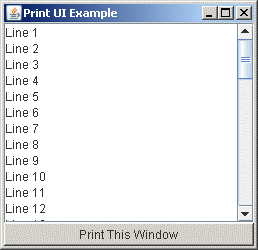Lesson: Printing
The Java Tutorials have been written for JDK 8. Examples and practices described in this page don't take advantage of improvements introduced in later releases and might use technology no longer available.
See Dev.java for updated tutorials taking advantage of the latest releases.
See Java Language Changes for a summary of updated language features in Java SE 9 and subsequent releases.
See JDK Release Notes for information about new features, enhancements, and removed or deprecated options for all JDK releases.
Printing the Contents of a User Interface
Another common printing task is to print the contents of a window or a frame, either in whole, or in part. The window may contain the following components: toolbars, buttons sliders, text labels, scrollable text areas, images, and other graphical content. All of these components are printed using the following methods of the Java 2D printing API:
java.awt.Component.print(Graphics g); java.awt.Component.printAll(Graphics g);
The following figure represents a simple user interface.

The code to create this UI is located in the sample program
PrintUIWindow.java.
To print this window, modify the code in the earlier examples which printed text or images. The resulting code should appear as follows:
public int print(Graphics g, PageFormat pf, int page)
throws PrinterException {
if (page > 0) {
return NO_SUCH_PAGE;
}
Graphics2D g2d = (Graphics2D)g;
g2d.translate(pf.getImageableX(), pf.getImageableY());
// Print the entire visible contents of a
// java.awt.Frame.
frame.printAll(g);
return PAGE_EXISTS;
}
Note: The call to the
printAll method is the only difference between this example and examples to print text or image. The print(Graphics g) method mirrors the java.awt.Component.paint(Graphics g) method used for on-screen rendering. Use the print() method rather than the paint() method as the Components class may have overridden the print() method to handle the printing case differently.
The printAll(Graphics g)method prints the component and all its subcomponents. This method is usually used to print object such as a complete window, rather than a single component.